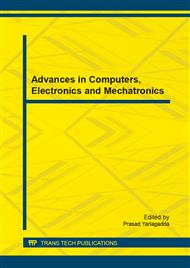[1]
Frank Chen,Zvi Drezner,Jenniferk et al.: Quantifying the Bullwhip Effect in a simple supply chain: the Impact of Forecasting,Lead-times,and Information. Management Science, Vol. 46(2000), pp.436-443.
DOI: 10.1287/mnsc.46.3.436.12069
Google Scholar
[2]
Karel,LauIa,Mare: The use of advance demand information in a project-based supply chain. European Journal of Operational Research. Vol. 130(2001), pp.519-538.
DOI: 10.1016/s0377-2217(99)00411-7
Google Scholar
[3]
U.W. Thonemann: Improving supply-chain performance by sharing advance demand information. European Journal of Operational Research. Vol. 142(2002), pp.81-107.
DOI: 10.1016/s0377-2217(01)00281-8
Google Scholar
[4]
LIAO Nuo, WU Ju-hua: A Model for The Value of Demand Information Sharing in A Two stage Supply Chain. Logistics Engineering and Management. Vol. 32(2010), pp.57-59. (In Chinese).
Google Scholar
[5]
Yonghui Fu, Rajesh Piplani : Supply-side collaboration and its value in supply chains. European Journal of Operational Research . Vol. 152(2004), pp.281-288.
DOI: 10.1016/s0377-2217(02)00670-7
Google Scholar
[6]
Anthony Creane: Productivity information in vertical sharing agreements. International Journal of Industrial Organization. Vol. 25( 2007), pp.821-841.
DOI: 10.1016/j.ijindorg.2006.08.003
Google Scholar
[7]
Boray Huang, Seyed M. R. Iravani: Production Control Policies in Supply Chains with Selective-Information Sharing. Operations Research . Vol. 53(2005), pp.662-674.
DOI: 10.1287/opre.1040.0203
Google Scholar
[8]
Ming-Min Yu: Evaluating the cross-efficiency of information sharing in supply chains. Expert Systems with Applications. Vol. 37(2010), pp.2891-2897.
DOI: 10.1016/j.eswa.2009.09.048
Google Scholar
[9]
CharnesA W, CooperW W, Rhodes E: Measuring efficiency of decision making units. European Journal of Operational Research. Vol. 2 (1978), pp.429-444.
DOI: 10.1016/0377-2217(78)90138-8
Google Scholar
[10]
Sexton T R , Silkman R H , Hogan A J : Data envelopment analysis : Critique and extensions . 73 - 104(1986).
Google Scholar
[11]
JING Hao, ZHAO Xinan: A New Thought on Cross Efficiency Evaluation in DEA. Operations Research and Management. Vol. 17(2008), pp.46-51.
Google Scholar
[12]
Doyle J R, Green R: Efficiency and cross-efficiency in data envelopment analysis: derivatives, meanings and uses. Journal of the Operational Research Society. Vol. 45(1994), pp.567-578.
DOI: 10.1057/jors.1994.84
Google Scholar


